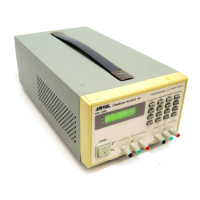13
STABILITY: When the supply is connected for remote sensing, it is possible for the impedance of the load wires
and the capacitance of the load to form a filter, which will become part of the supply's CV feedback loop. The extra
phase shift created by this filter can degrade the supply's stability and can result in poor transient response
performance. In extreme cases, it can cause oscillation.
It is difficult to state simple rules defining the conditions under which this can occur, and which corrective action
to take. A certain amount of trial and error may be called for. Two guidelines which are almost always valid are:
a. Keep the leads as short as possible.
b. Twist the load leads together to minimize inductance.
In most circumstances, once these two guidelines are followed, problems associated with the load lead inductance
are eliminated. This leaves the load lead resistance and load capacitance as the major cause of the reduced stability.
In this case, you may obtain further improvement to the stability by:
a. Keeping the load capacitance as small as possible.
b. Increasing the diameter of the load lead to reduce resistance.
If heavier gauge load leads ( #10 or greater ) are used, circumstances may arise when the load lead inductance and
the load capacitance can form an underdamped filter. This filter occasionally has the effect of destabilizing phase
response. In this case, the above steps can worsen stability since they will reduce damping in the system.
3.4 LOAD CONSIDERATION AND MULTIPLE LOADS CONNECTION
When the supply is in local sensing mode and you are connecting multiple loads to the output, connect each load to
the output terminal using separate load leads. This minimizes mutual coupling effects and takes full advantages of
the supply's low output resistance. Each pair of wires should be as short as possible and twisted or bundled to
reduce lead inductance and noise pickup.
If cabling considerations require the use of distribution terminals that are located remotely from the supply,
connect the power supply output terminals to the remote distribution terminals by a pair of twisted or bundled
wires. Connect each load to the distribution terminals separately. Remote voltage sensing is recommended in these
circumstances. Sense either at the remote distribution terminals or, if one load is more sensitive than the others,
directly at the critical load.
OUTPUT ISOLATION: The output of the power supply is isolated from earth ground. Either output terminal may
be grounded, or an external source of voltage may be connected between either output and ground. However, both
output terminals must be kept within +/-240Vdc of ground. This includes the output voltage. An earth ground
terminal is provided on the rear panel terminal block.
Each of the power supplies will operate accordingly to the various types of loads connected to the output.
CAPACITANCE LOADING: In normal conditions, the supply will be stable for almost any size load capacitance
(for remote sense stability considerations). However, large load capacitance may cause ringing in the supply's
transient response. It is even possible that certain combinations of capacitance and ESR (equivalent series
resistance) will result in instability. If this is the case, the solution is to increase or decrease total load capacitance.
In addition, the overvoltage protection SCR crowbar circuit has been designed to discharge capacitance up to a
certain limit. These limits are:
1. For models with maximum output voltage below 32 Volts, Capacitance should not exceed 5000uF.

